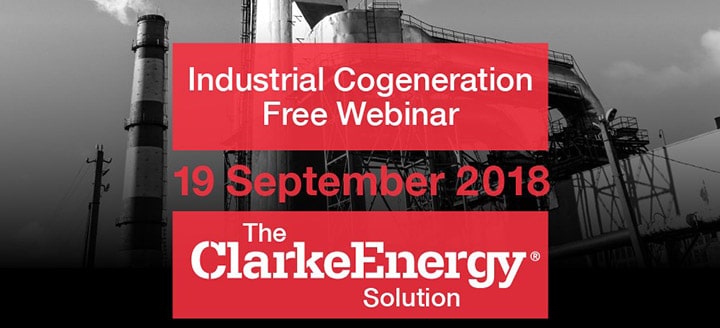Spend more than £25k per year on energy and want to significantly lower your CO2 emissions?
Join us as we discuss how the industrial sector can save significant amounts in energy costs, through the installation of a combined heat and power (CHP) plant.
Heat in the form of hot water or steam can be utilised for local use, or cooling via the use of an absorption chiller. There is also the possibility to recover CO2 for process use. CHP, if designed and installed correctly, makes the ideal business case, allowing critical spend to be diverted to the areas of your business that matter. Our team will be on hand to answer your questions, and to provide detailed feasibility studies, demonstrating your businesses potential savings. Please register to be educated about the benefits CHP.
Speakers

Lee Christian- Natural Gas CHP Specialist
Increase profit and energy resilience with CHP
Lee manages Clarke Energy’s UK’s Industrial CHP schemes, across all manufacturing sectors, including automotive, chemicals and food and drink.

Caroline Bragg -Senior Policy Manager
Finding opportunities from changing markets and regulation
Caroline leads the development of the Association for Decentralised Energy’s power sector policy and regulatory work, focusing on combined heat and power and demand-side energy services.
Alan Frost – Commercial Operations Manager
Ensuring high availability of your generating set
Alan manages Clarke Energy’s commercial service contracts across all sectors including some of the nation’s best loved brands.
Benefits of CHP:
- – Typical fuel efficiency of 80-90%
- – Energy cost savings of up to 40% when designed and installed correctly
- – Significant reduction in carbon emissions
- – Resilient building infrastructure that can supply power in the event of a grid failure
Combined heat and power is a measure that offers a significant opportunity to reduce energy costs, and to improve an industrial plant’s environmental performance. Existing customers are currently making an energy saving typically up to 40%.
Many industrial plants across Britain are reliant on the national grid and conventional boilers fuelled by natural gas for intensive power supplies. Self-generation of power onsite through combined heat and power (CHP) technology is a cost-effective solution to address unnecessary spend, when designed and installed correctly.
In order to benefit from the full potential of CHP, organisations need to ensure that their projects are sized and designed precisely. Clarke Energy will provide a business with a full feasibility study, assessing heat and power demand, to provide the best possible solution to match CHP engine with the local requirements.
Combined heat and power is a highly efficient process that captures and utilises heat that is a by-product of the electricity generation process. By generating heat and power simultaneously, CHP can reduce carbon emissions by up to 30% compared to the separate use of a conventional boiler or power station.
CHP Delivers Stable Power Supplies
Utilising the local natural gas supply network gas engine-based CHP systems provide a stable supply of electrical power that, if needed, can be isolated from the local electricity grid. Heat produced by the engine can be recovered either as hot water or as steam for use in the industrial facility. In addition, if there is a local need for cooling power, the heat can be fed into an absorption chiller providing a source of cold water. This cold water can in turn be used to support a refrigeration or air conditioning system. Systems providing electricity, heat and cooling are called trigeneration plants. This can be taken one step further for industrial users that require carbon dioxide. Carbon dioxide can be recovered and scrubbed from the engine exhaust to the highest standards. There are various applications for this carbon dioxide including ones in the food and drinks industry or in greenhouses for the promotion of growth in plants.
CHP Can Improve Environmental Performance
Natural gas has the lowest levels of carbon dioxide production and is the cleanest of all the fossil fuels. Jenbacher gas engines generate electricity at high efficiency making the greatest use of the fuel source. The utilisation of cogeneration for embedded generation helps minimise losses of electricity associated with its transmission from centralised power plants. With the addition of carbon dioxide recovery systems, carbon dioxide can be sequestered in plants or utilised in manufacturing processes, helping provide the highest levels of environmental performance.
Register for the free webinar here






